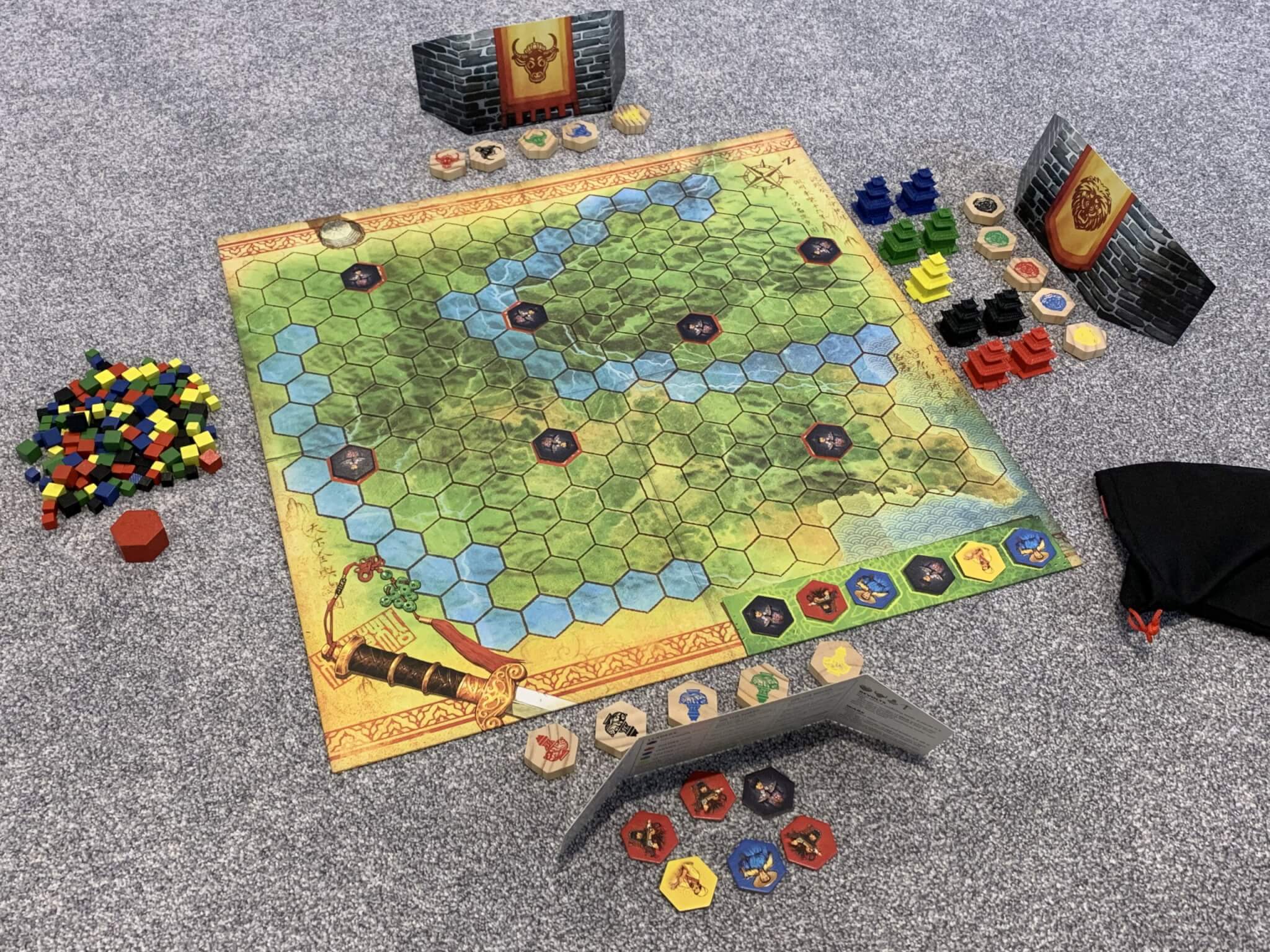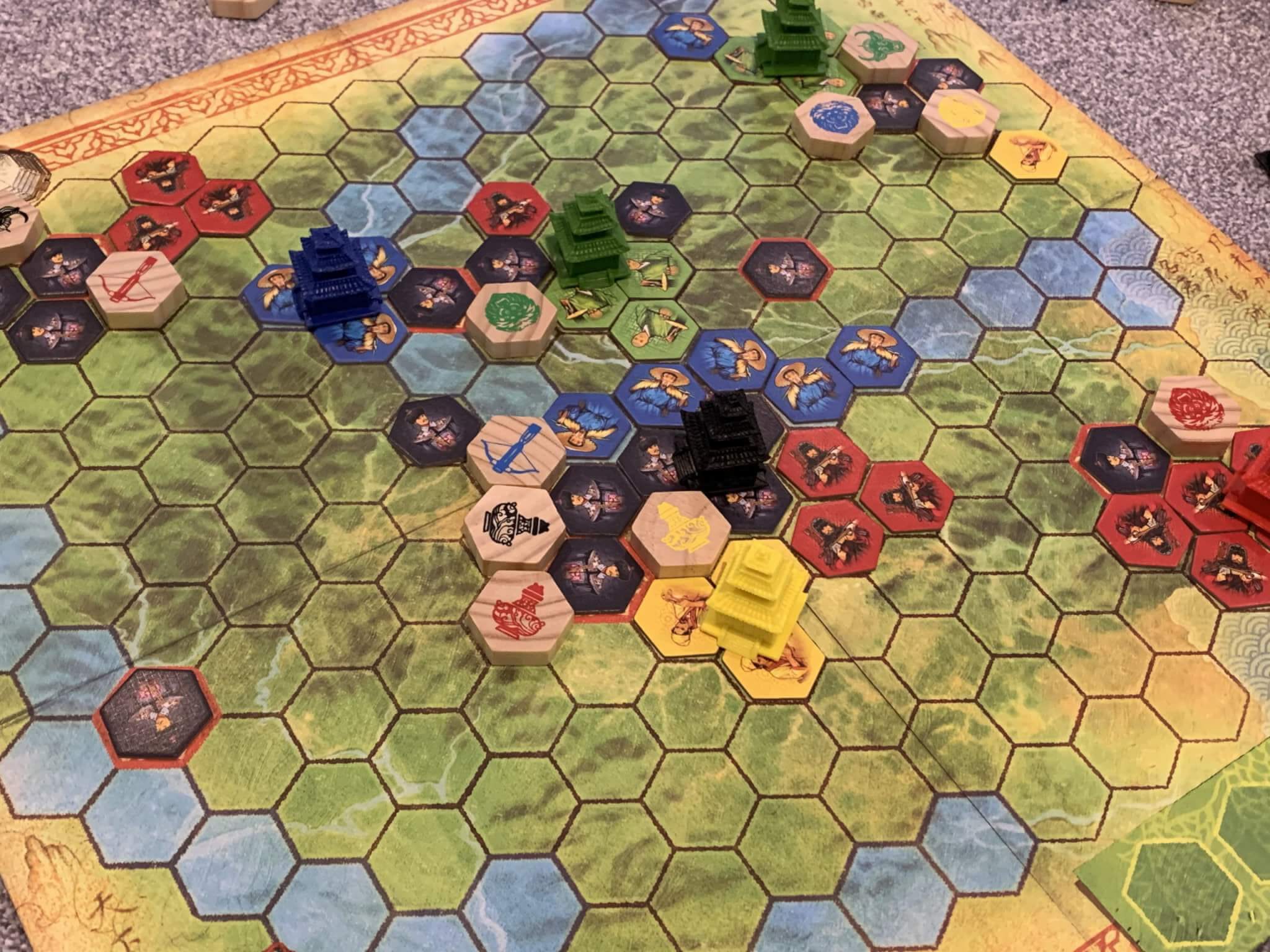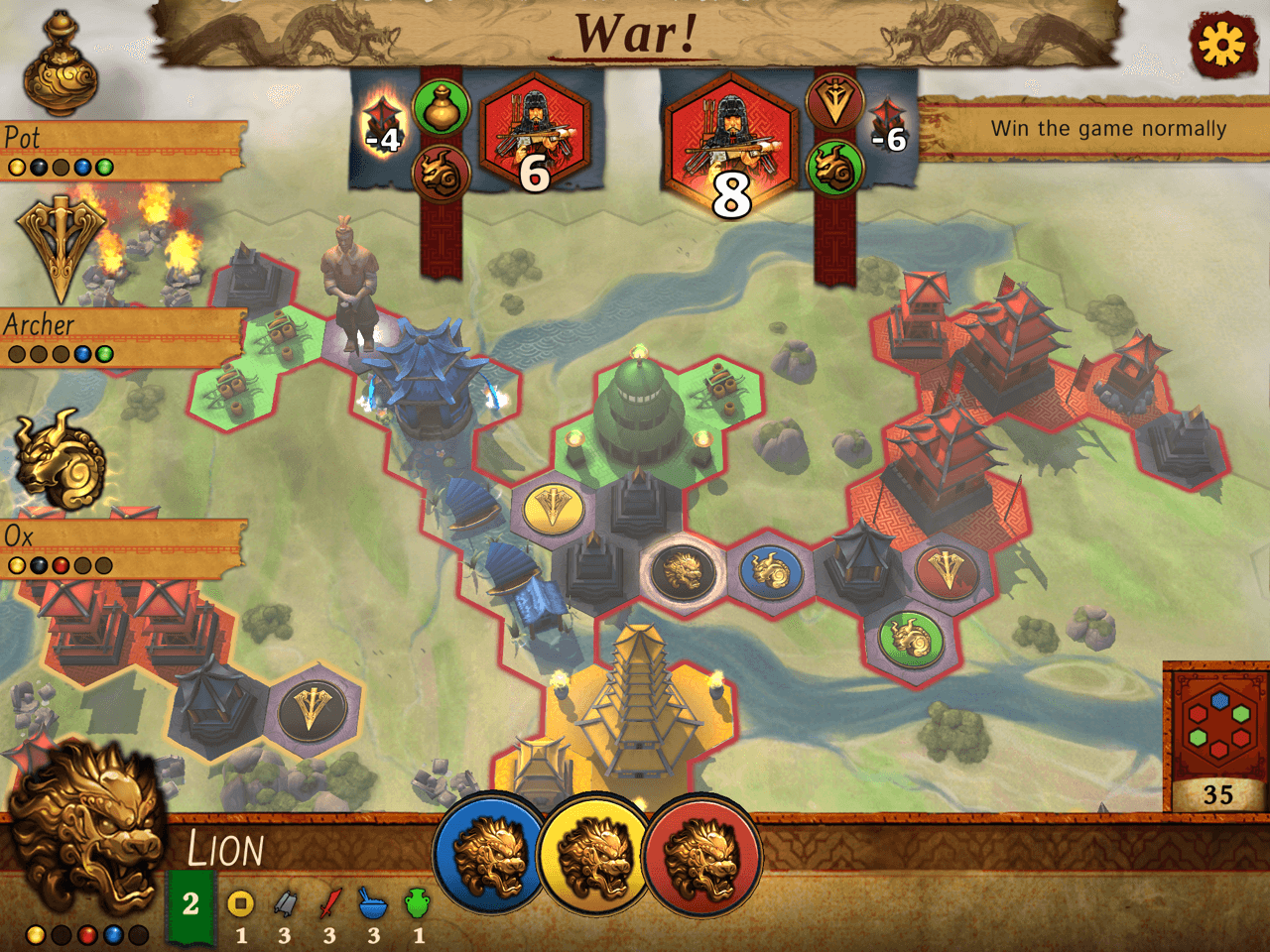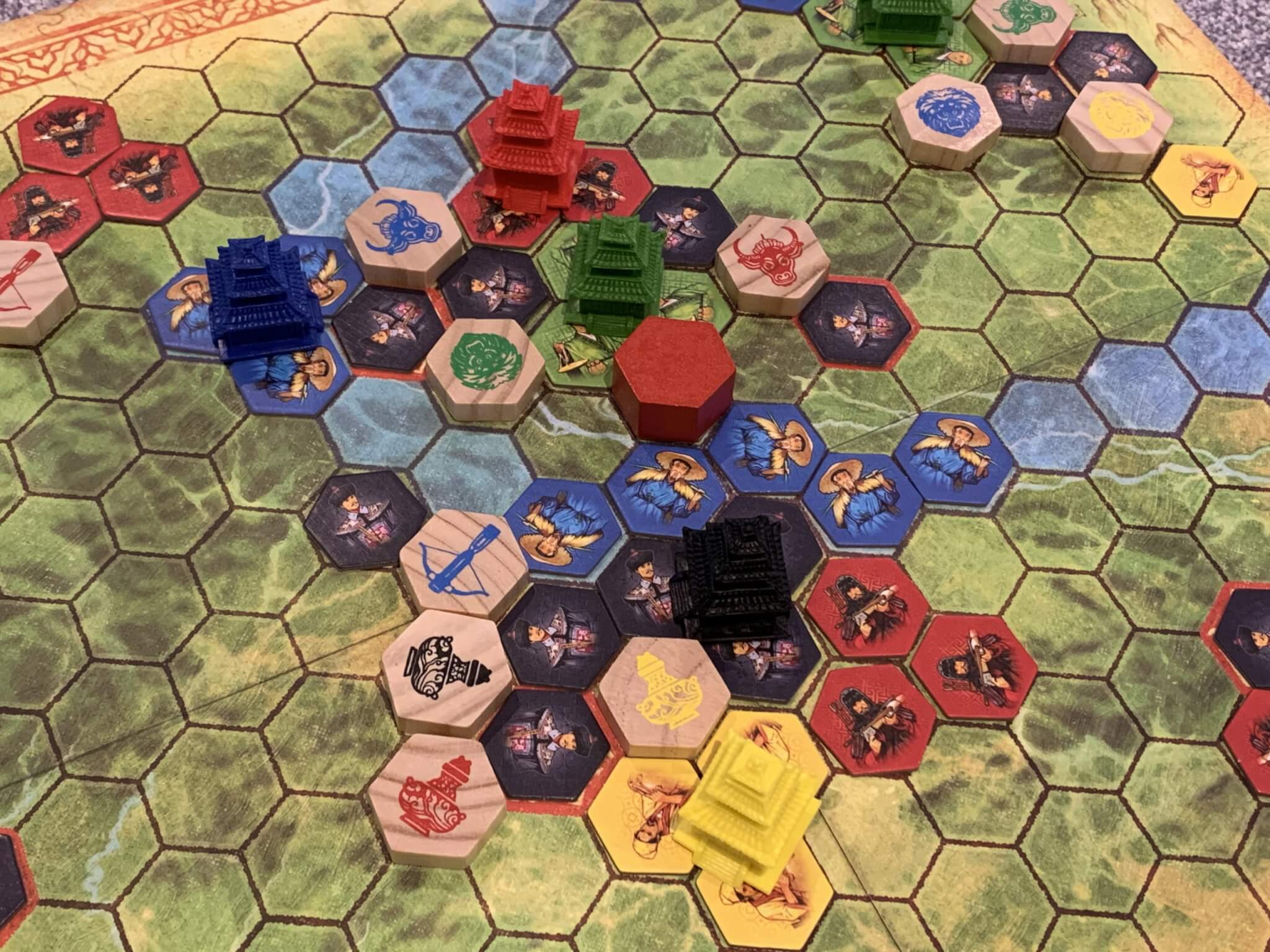Yellow & Yangtze is the semi-sequel to Tigris and Euphrates, with both games featuring a similar design from the now legendary Dr. Reiner Knizia. This later version moves the theme from Mesopotamia to China and publisher Grail Games has not been shy about producing exceptional components. For those who prefer gaming on the go, an mobile and PC adaptation is available via Direwolf Digital.
Upon opening the box for Yellow & Yangtze, you won’t be too surprised to learn that the game is relatively complex. The basic flow of the game is simple, but there are some complex rules relating to how the different pieces interact on the board that takes time to learn, and over and above that, actually learning how to play well can take a fair while.
Because of this, I was very keen to use the digital adaptation of the game to help me learn it, and whilst the digital implementation is excellent in its own right, it also serves its purpose to teach the game extremely well. Yellow & Yangtze is all about placing leaders that represent your faction in such a way that they influence the board in a way to suit you, and when two of the kinds of leader share a state, all hell breaks loose!

Before getting into too much detail, let’s take a brief step back and get a high-level overview of the game. Yellow & Yangtze supports two to four players, each of who will be assigned a faction symbol, a screen (to hide their pieces) and five leader pieces, each representing a different colour. A bag will be loaded with a number of cardboard hexagons, each again representing one of the five colours.
The board will be set up to include a number of starting states, each of which will be represented by a single governor (black) tile. The players will draw a hand of six tiles from the bag, which will be kept secret behind their screen — their leader chips will usually be placed in front of the screen for all to see, except when they are put onto the actual board.
The purpose of the game is to score points in each of the five colours, with red, blue, green and black all scoring in their own right. Yellow acts as a wild card that will be split across the others as the players see fit. The winner will be the player who scores the highest in their lowest-scoring colour, so for example if you neglect one colour entirely then you’ll almost certainly lose, unless it’s yellow, in which case you simply won’t gain any bonus.

During gameplay, players will score points for placing tiles of matching colours into states that their leaders are attached to. Place a blue (farmer) hexagon into a state where your blue leader is and you score, it’s that simple. When three matching hexagons sit together in a triangle shape, a pagoda can be formed, and whichever leader controls it will score one point per turn in that colour.
There can only be two pagodas of each colour at any one time (one of the wild yellow colour) and so when you have the option to build a pagoda and they are already out on the board, you may take a pagoda from one of the other locations and build it yourself. This is just one of many, many directly confrontational aspects to Yellow & Yangtze that give it a fiercely competitive and often cruel nature — which I love.
It’s worth noting that any leader must be placed next to a governor token, and the number of governor tokens adjacent to a leader token will add strength to that leader during a revolt. A revolt happens whenever a leader is added to a state that already has a leader of the same colour. When this happens, the players compare the number of adjacent governors that each leader has to generate a base strength.

Each player may then add the strength of their governor leader (if it is in their hand) to their side, and they may discard any number of governor tiles from their hand to further increase the strength. When both players (beginning with the offensive player) have declared their strength, the winning leader remains and the losing one is removed.
Similar to a revolt but with the red military leader and tokens as the currency for adding strength is a war, which happens when two states are joined as the result of a token being placed. In this case, there may be any number of leaders on each side, each of whom could be in jeopardy depending on whether the opposing state has a leader of the same kind. To summarise this another way, at the end of the war the two states may become one, but there will always only be one leader of each kind remaining.
I find war confusing, even now, because whilst the digital app calculates the outcome for you, it can be hard to translate the complex situations onto the board. Aside from the base strength, there are often numerous military units to consider, tokens being discarded and so on, which ultimately results not only in the outcome of the war, but also in several military buildings being removed from the board.

Simply put, the bigger and more complex the war, the more likely you are to make a mistake – that’s okay though because eventually it will come to you and once you understand the rules, you simply work through the board state in a methodical manner. If anything, whilst the app is very helpful for learning the principles of war, you’ll actually need to “do the maths” on the physical board game to fully understand the different nuances.
Although that’s a fair bit to take in, the turn to turn play in Yellow & Yangtze is very straightforward and fast. On a turn, a player simply has two actions, with each action being to place one token, place one leader, discard and redraw any number of their tokens or to perform a peasant revolt (which is not the same as the revolt I’ve described above).
Whilst we’re briefly touching on peasant revolts, let me touch upon some of the unique aspects of the tokens themselves. Farmers (blue) can only be placed on river spaces, but when you do place one of them, you can then place as many as you have (as long as they are adjacent to the previous one) as part of the same action. Farmer tiles can also be discarded to cause peasant revolts, allowing the player who caused the revolt to remove a governor tile (forcing any adjacent leaders who are now ungoverned to be removed as well.)

Governor tiles (black) only have the effect of allowing leaders to be placed next to them and adding their strength during a revolt, whilst red military tiles are similar, but without any special placement effects. Yellow tiles don’t do anything, but they are rare and of course, the yellow points are wild at the end of the game. Finally, the green merchant tiles allow the player who places them to draw a replacement tile from a face-up selection of six, where normally tokens are replenished blindly from a bag.
So with all of that mechanical stuff out of the way, let’s talk about what Yellow & Yangtze feels like to play. Honestly, it’s amazing. I mean really, truly amazing. Yellow & Yangtze is as compulsive to play as some of the most classic games — I’m talking about Chess here, not Settlers of Catan or something like that. It’s the kind of game where you finish playing and you immediately want to start again.
When playing with four players with a physical copy, you’ll be looking at about ninety minutes per game. At two, maybe more like an hour. For the digital version, you can have a game done and dusted in fifteen minutes and be ready for the next one within a few clicks, which is obviously the way to go for solo players — although the multiplayer version also includes both online play and local “Pass and Play” which is lovely.

When playing with just one other person, there is most certainly the compulsion to play over and over again, especially because Yellow & Yangtze has such direct confrontation in it. It’s important to remember that players don’t actually “own” or “control” states and therefore, it’s possible that war can erupt where you have leaders on either side. Even so, at two players, in particular, there’s a lot of back and forth gameplay that will result in curses and cries of anguish.
At three or four players, the board obviously feels more confined and there is a more chaotic flow to the way in which the leaders of each side rise and fall due to the constant ebb and flow of power between the players. One player might claim a powerful position in a state following a war, but another player will likely know that they probably won’t have the red tokens needed to fight a second war.
Aside from the overall competitive nature of the game, there are some very interesting aspects to think about simply when targeting the optimal score. For starters, there are fewer yellow tokens in the bag, for example, so gaining a yellow pagoda early in the game is very valuable. Green tokens can help with that if any yellow tokens appear in the face-up selection, but such a strategy can be slow.

Blue cannot be ignored because it is one of the four core scoring areas, but using blue farmer tokens to cause revolts and remove enemy leaders is also a very powerful option. The fact that blue can only ever be placed on rivers is also interesting, and it will often be the placement of a run of blue tiles that ignites war between two states on either side of the titular rivers. Scoring five or six points in blue early can often mean it can be ignored for the remainder of the game, but simply aiming to capture someone else’s blue pagoda during the midgame is also perfectly viable.
You can probably tell by now that I love Yellow & Yangtze and my only criticism of it is that still takes me a few minutes to oil my brain in relation to how wars work each time I play. Everything else about it, whilst often demanding or complex at a decision making level is remarkably straightforward. The pieces are clear and minimal, but bright and adorned with gorgeous artwork that looks fabulous when set up.
Yellow & Yangtze is without a doubt a superb board game and it is by far and away my favourite Reiner Knizia game to date. I love it at all player counts and I think the crunchy, often venomous gameplay is excellent if you have a group of people who can stomach it. Obviously, if your group prefers to avoid any form of confrontation then you may wish to look elsewhere, but even still, Yellow & Yangtze is worth just trying to see if it breaks the mould.
You can find the digital version of Yellow & Yangtze on Android, iOS and PC. You can find the tabletop version of the game on Amazon.
Love both video games and board games? Here’s our list of some fantastic crossover games.
